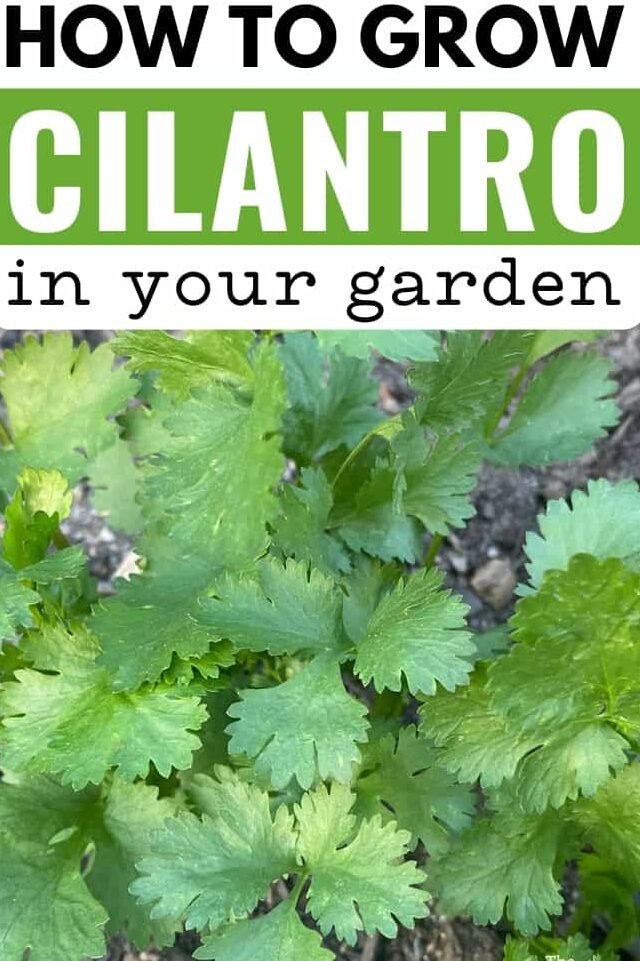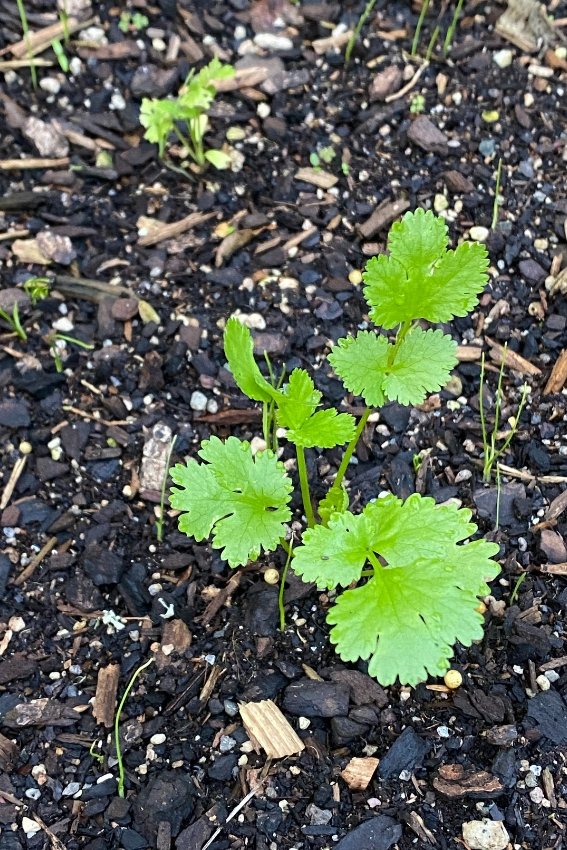
Cilantro is an incredibly versatile herb that’s a must-have for any garden, whether you’re a seasoned gardener or just starting out. Not only is it easy to grow, but once you have it in your backyard, you’ll never need to run to the store for fresh cilantro again!

With minimal care, you can enjoy a steady supply of this fragrant herb all season long. Imagine making your own salsa, guacamole, or any cilantro-heavy dish without having to rely on store-bought bunches. Let’s dive into how you can grow cilantro in your garden and reap the benefits of having fresh herbs at your fingertips.
What is Cilantro?
Cilantro (scientific name Coriandrum sativum) refers to the leaves of the coriander plant, which means you actually get two plants in one! The leaves, known as cilantro, are great for cooking in the spring, and as the plant matures and starts to produce seeds, those coriander seeds can also be harvested and used in various recipes, such as spice blends.
The beauty of cilantro lies in its versatility. You can use the fresh leaves throughout the spring, and once the plant goes to seed, you can collect those seeds for a different culinary experience. If you’re strategic, cilantro can provide fresh flavor year-round with a little planning.
The Basics: How to Grow Cilantro in Your Garden
Cilantro is a popular herb known for its bright, fresh flavor. Luckily, it’s not hard to grow, and it doesn’t require much upkeep. With a few simple steps, you can have cilantro thriving in your garden in no time
Choosing the Right Cilantro Variety

Before you dive into planting, it’s important to choose the right type of cilantro for your growing conditions. Cilantro can be a little tricky in warmer climates, as it tends to bolt (go to seed) when temperatures rise above 75°F. If you live in a hotter area, look for slow-bolting varieties, which are designed to grow longer before producing seeds.
Some good varieties to try include:
- Slow-Bolt
- Calypso
- Jantar
- Santo
These varieties will allow you to harvest fresh leaves for a longer period before the plant starts to go to seed.
Starting Cilantro From Seed
Cilantro is easily started from seed, making it a simple and cost-effective option for gardeners. You can either start cilantro indoors to get a jump on the season, or plant directly in your garden once the danger of frost has passed.
One of the great things about cilantro is that it self-seeds. If you let the plant go to seed in your garden, it will reseed itself, providing you with cilantro in the spring and fall seasons without having to replant.
Here’s how to start cilantro indoors:
- Soak the Seeds: Soak cilantro seeds in water overnight. This softens the hard outer coating, helping the seeds sprout faster.
- Plant the Seeds: Fill trays or small pots with potting mix or garden soil, and plant the seeds about ¼ inch deep.
- Provide Warmth & Sunlight: Place your trays in a warm area with plenty of sunlight or use a grow light.
- Watering: Keep the soil evenly moist, but not soggy. Water regularly until the seeds germinate.
When to Transplant: Cilantro seedlings can be transplanted outdoors about 2-3 weeks before your last frost date.
When to Plant Cilantro

Cilantro thrives in cooler temperatures, so it’s best to plant it in early spring or late summer, before the heat sets in. If you plant cilantro too late in the spring, the plant may bolt prematurely due to the rising temperatures.
Ideally, plant your cilantro seeds right before or at your last frost date to give it the best chance for growth. If you’re looking for a steady supply, consider succession planting. This means planting a new batch of cilantro seeds every couple of weeks throughout the growing season. Once temperatures hit around 70°F, stop planting and wait until late summer to plant again for a fall crop.
You can also allow your spring cilantro to go to seed, which will self-sow and sprout new plants the following season.
Where to Plant Cilantro
Cilantro grows best in full sun but can tolerate some partial shade. It needs at least six hours of sunlight per day to thrive. If you’re planting cilantro in an area with intense afternoon sun, consider choosing a spot that gets some shade during the hottest part of the day. This can help extend the growing season and improve the quality of your harvest.
Soil: Cilantro prefers well-drained soil. Before planting, enrich the soil with compost or aged manure to improve its ability to retain moisture and nutrients. For container gardening, use a potting mix rich in organic matter.
Companion Planting: Cilantro can also be a great companion plant. For example, planting cilantro near eggplants can provide shade during the hottest parts of the day and help deter pests from your other plants.
How to Plant & Care for Cilantro

Once you’ve picked the perfect spot for your cilantro, it’s time to plant.
- Transplanting: If you’re transplanting seedlings, dig holes about 3-4 inches apart. Be gentle with the roots, as cilantro has a long taproot, which can be delicate.
- Direct Seeding: If you’re planting seeds directly in the garden, space them about 1-2 inches apart and plant them about ¼ inch deep.
- Watering: Cilantro needs regular watering. Keep the soil moist, but not soggy. Water deeply once a week, or more often if it’s particularly hot and dry.
- Thinning: As the plants grow, thin them out once they reach 4-5 inches tall to allow for proper spacing—about 10-12 inches apart.
Cilantro is a low-maintenance herb that doesn’t require much attention once established. Just make sure it gets enough water and sunlight, and it should thrive.
Dealing with Cilantro Pests & Diseases
Cilantro is naturally resistant to most pests and diseases, which makes it a hassle-free herb to grow. Its strong aroma tends to repel many common garden pests. Additionally, once cilantro flowers, it attracts beneficial insects like bees and ladybugs that can help control pest populations.
However, cilantro isn’t completely immune. It can sometimes be affected by aphids or fungal blights. One of the biggest concerns is root rot, which often occurs when the plant is overwatered or the soil doesn’t drain well.
To prevent root rot, make sure to water properly and ensure the soil drains well.
Harvesting Cilantro
You can start harvesting cilantro as soon as the leaves are big enough to use, but waiting until the plants are about 6 inches tall will give you a better yield. To harvest, simply cut off the outer leaves at the base of the stem, leaving the growing tip intact to encourage new growth.
For a continuous supply of cilantro, pick only a few leaves from each plant at a time. This will keep the plant growing and delay bolting for a longer harvest period. However, once temperatures rise, your cilantro will inevitably bolt, signaling the end of the growing season.
Storing Cilantro
Cilantro doesn’t store very well, so it’s best to use it right after harvesting. However, if you want to extend its shelf life, try this trick:
- Wash and dry the cilantro thoroughly (a salad spinner is great for this).
- Wrap the cilantro in a paper towel.
- Store it in a sealed ziplock bag or airtight container in the fridge.
For long-term storage, cilantro can be frozen. Just chop it up and place it in a freezer bag. No need to thaw before using—just toss it straight into your dish!
With these tips, you’ll be able to grow cilantro in your garden and enjoy fresh, flavorful herbs all season long. It’s a simple and rewarding way to enhance your cooking and add some green to your backyard!
